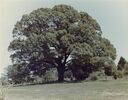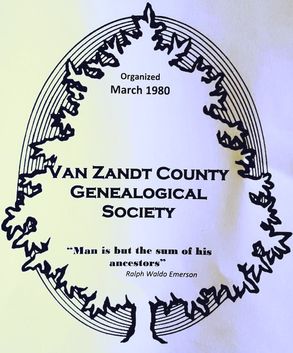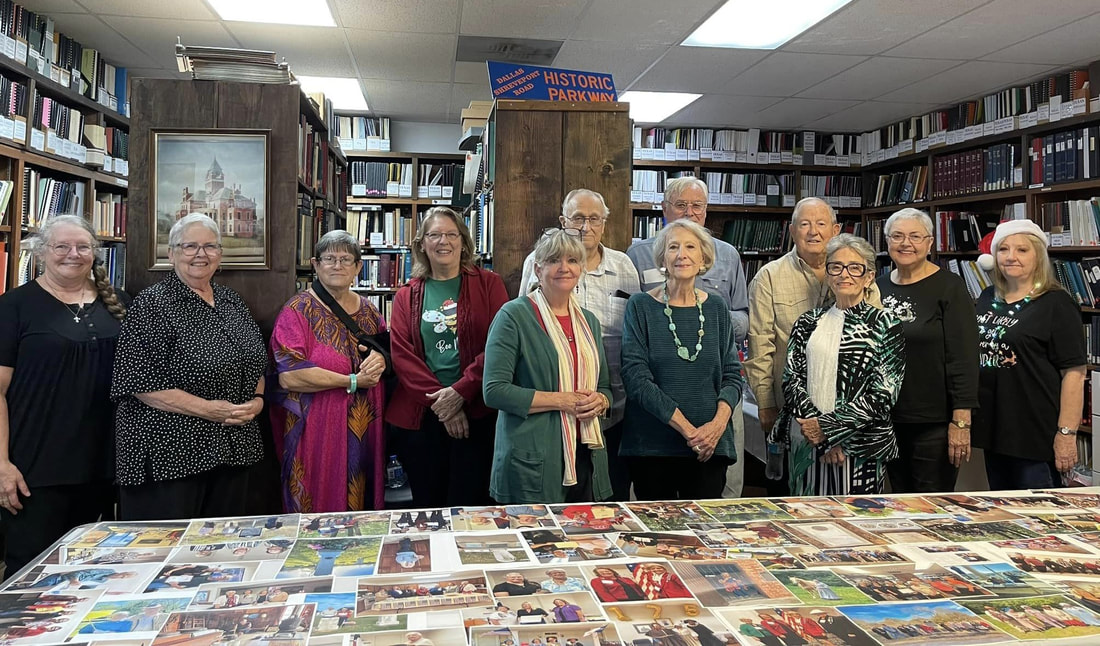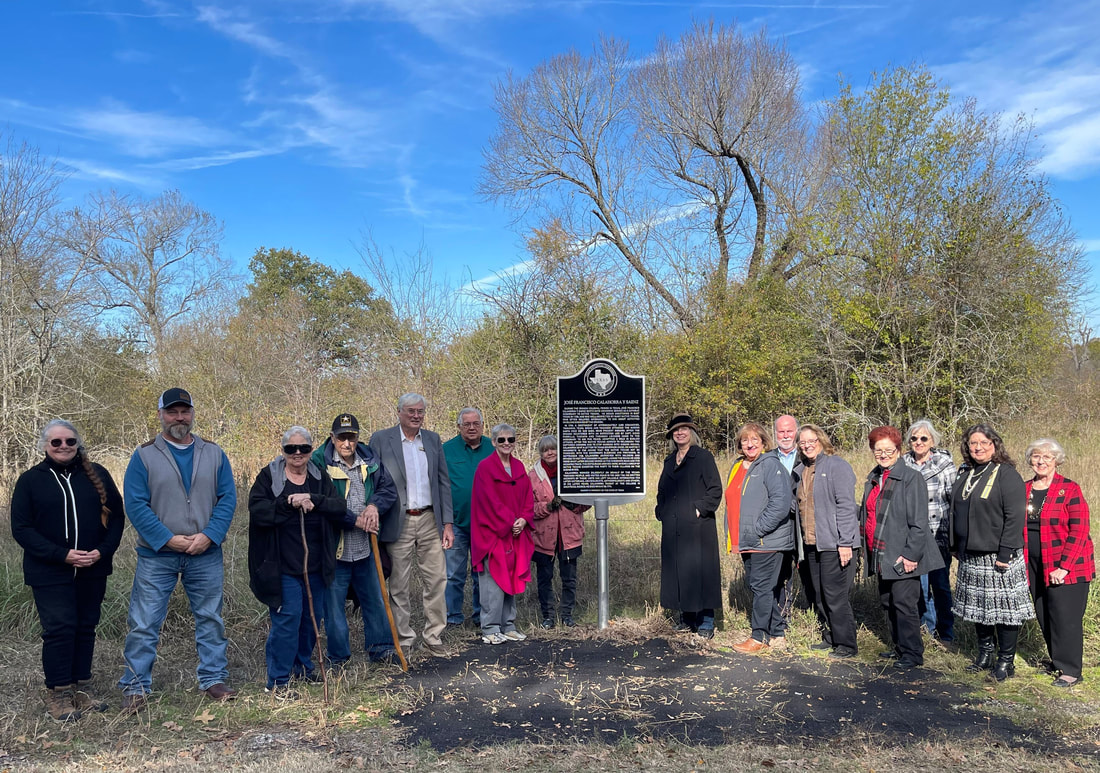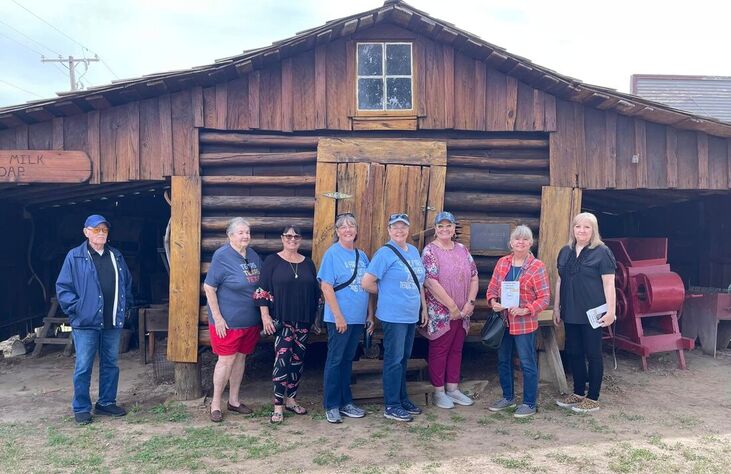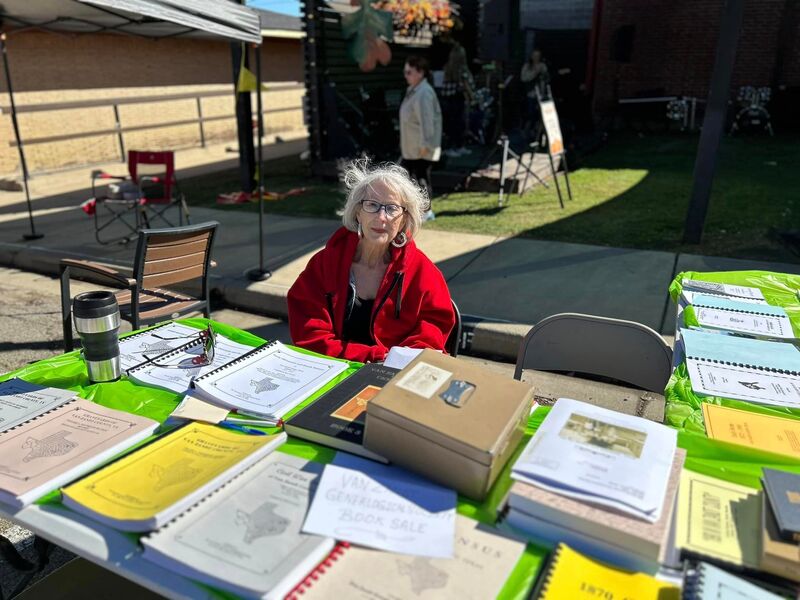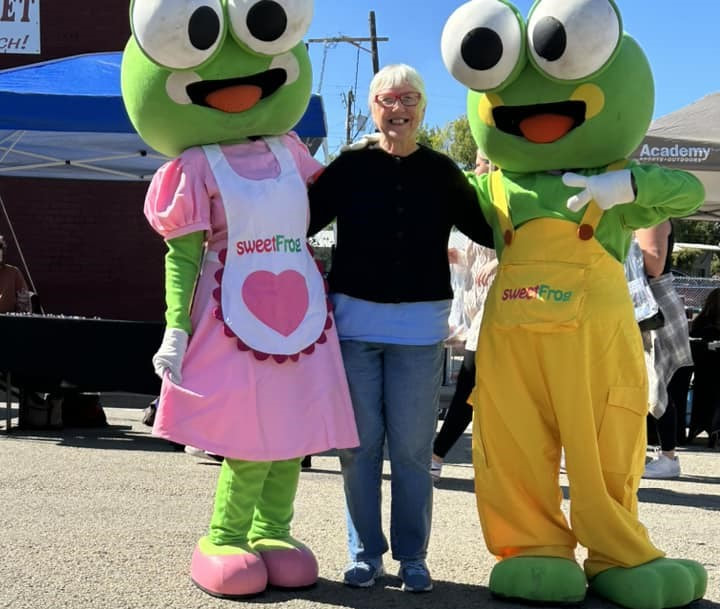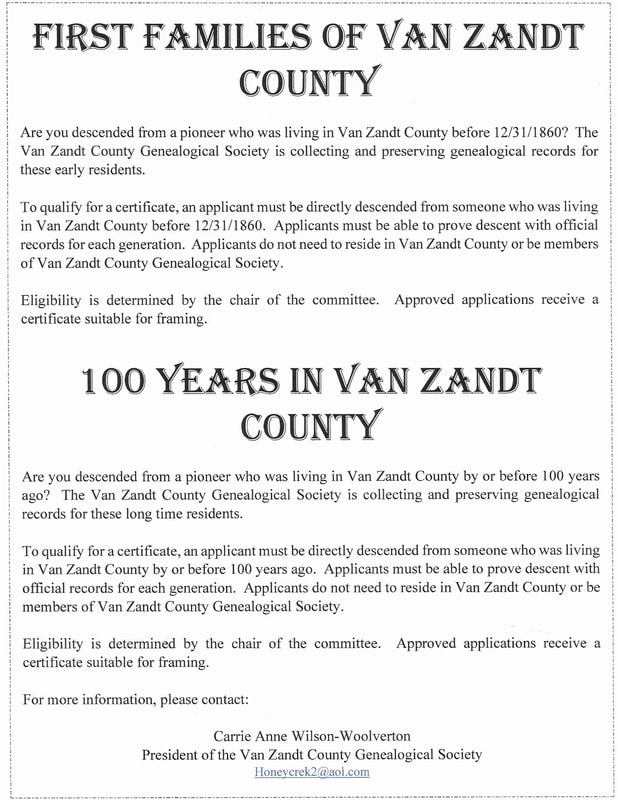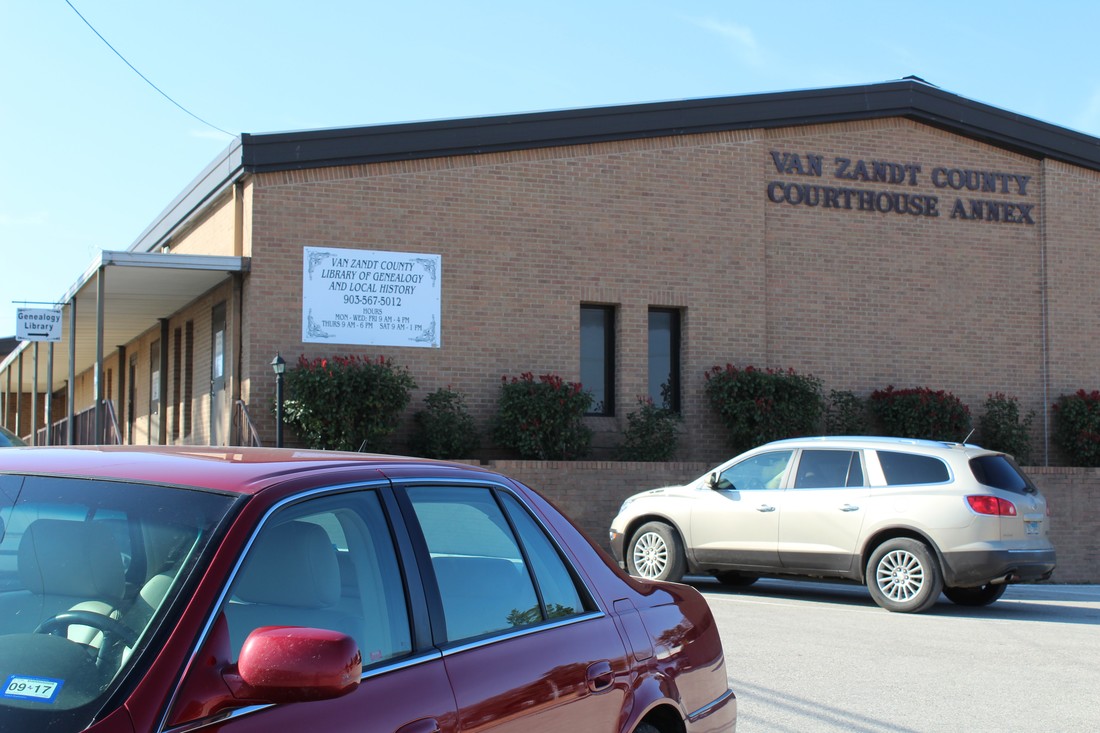The Genealogy Library has the following hours:
Monday: 10:00 a.m. - 3:00 p.m (NOTE: We recently extended Monday hours to 3:00!)
Tuesday: 10:00 a.m. - 3:00 p.m.
Wednesday: 10:00 a.m. - 3:00 p.m.
Thursday: 10:00 a.m. - 3:00 p.m.
Friday: 10:00 a.m. - 12:30 p.m. (closed Friday afternoon)
Saturday: 10:00 a.m.- 12:30 p.m. (closed Saturday afternoon)
Monday: 10:00 a.m. - 3:00 p.m (NOTE: We recently extended Monday hours to 3:00!)
Tuesday: 10:00 a.m. - 3:00 p.m.
Wednesday: 10:00 a.m. - 3:00 p.m.
Thursday: 10:00 a.m. - 3:00 p.m.
Friday: 10:00 a.m. - 12:30 p.m. (closed Friday afternoon)
Saturday: 10:00 a.m.- 12:30 p.m. (closed Saturday afternoon)
Welcome to the website of the Van Zandt County Genealogical Society and the Van Zandt County Library of Genealogy and Local History! See contact information at the bottom of this page, including for other organizations that provide historical and genealogical help. Our most recent events, and upcoming activities can be found on this page, below. Use our navigational toolbar above to get to know us, including our About page regarding our purposes and mission.
Be sure and keep up with us also on our Facebook site.
Be sure and keep up with us also on our Facebook site.

Looking for the "regular" (non-genealogy) Van Zandt County library? The Sarah Norman Library is at a separate location, at 317 First Monday Lane, Canton. A wonderful resource! Books, activities, fun for all ages!
Visit the main library in person or at vanzandtlibrary.org.
Visit the main library in person or at vanzandtlibrary.org.
Upcoming Events:
Van Zandt County Genealogical Society
For upcoming events, and for other interesting information, check out our Facebook page at https://www.facebook.com/VanZandtCountyGenealogy Most of our monthly meetings are free, they are all open to the public, and refreshments are served.
Become a member of the Van Zandt County Genealogical Society
Support local county/Texas history, make friends, achieve your family research goals even faster! Dues are $25 per year for an individual membership and $30 per year for a family membership. Members receive our award-winning quarterly publication Our Heritage. Call us during business hours (M-F 10:00 a.m.-3:00 p.m., Sat. 10:00 a.m.-12:30 p.m.) at 903-567-5012, or email us at [email protected] Or to pay by credit card via this website, go to our Store page, or click here. For information on membership and its benefits, go to our Membership page.
The Genealogy Library, located at 250 E. Grove St., Canton, Texas, is here to assist anyone wishing to do genealogy/family research or historical research. Our Library has computer terminals with access to services such as Ancestry, and the public is welcome. (You don't have to be a member of the Genealogical Society.) See our hours, above. We also take calls and emails for short research requests, at 903-567-5012, during business hours. Links to our email address and Facebook page, as well as other useful links, can be found at the bottom of this page. See video tour, below, of the Genealogy Library.
Beginner Genealogy Discussion at Regular Meeting July 27
Summer is a good time to get into family research!
The Van Zandt County Genealogical Society will have its regular meeting on Saturday, July 27, 2024, at 2:00 p.m., at the main county library, 317 First Monday Lane, in Canton. The program for the meeting will be “Beginner Genealogy.” Officers and librarians of the Society will answer questions about how to get started in family research. For those who are not sure where to begin, or who have recently started their family genealogy, this is a good opportunity to get information from experienced researchers. The librarians and officers will explain the resources available at the Genealogy Library in Canton, and will discuss how to use computers, books and microfilm to find family records. It will be a low-key, roundtable discussion, with an emphasis on practical answers.
Beginner genealogists are encouraged to come with questions. More experienced family researchers are urged to attend also, as they may have tips and stories to offer. All are welcome, membership is not required, and the meeting is free. Refreshments will be served.
The Van Zandt County Genealogical Society will have its regular meeting on Saturday, July 27, 2024, at 2:00 p.m., at the main county library, 317 First Monday Lane, in Canton. The program for the meeting will be “Beginner Genealogy.” Officers and librarians of the Society will answer questions about how to get started in family research. For those who are not sure where to begin, or who have recently started their family genealogy, this is a good opportunity to get information from experienced researchers. The librarians and officers will explain the resources available at the Genealogy Library in Canton, and will discuss how to use computers, books and microfilm to find family records. It will be a low-key, roundtable discussion, with an emphasis on practical answers.
Beginner genealogists are encouraged to come with questions. More experienced family researchers are urged to attend also, as they may have tips and stories to offer. All are welcome, membership is not required, and the meeting is free. Refreshments will be served.
Learning about Coats of Arms
“A picture is worth a thousand words.” Carrie Woolverton quoted the well-known proverb during her fascinating presentation of “Coats of Arms” at the Van Zandt County Genealogical Society meeting on June 22, 2024 at the main county library.
A coat of arms, said Ms. Woolverton (President of the Genealogical Society), was an image, usually painted on a shield in medieval times, that identified a particular person—often a king or knight or other leader. The image was a clear symbol that identified which person a soldier should rally behind as they went into battle. As time went on, such images—known generally as heraldry or armorial research-- became symbolic of aristocrats, government entities, and organizations like companies and social clubs. Coats of arms are still used this way, Ms. Woolverton noted: When you see the flag of the United States or the seal of the State of Texas, you are looking at a form of heraldry. She showed many examples of Coats of Arms and flags in her slide presentation, and had posted in the library meeting room many beautiful examples of coats of arms painted by Patsy Bass, a member of the Genealogical Society.
Ms. Woolverton stressed that the traditional shield-shaped coat of arms is not just a pretty picture: It is an image that was granted to a specific individual. Not all people who have the surname Windsor can say the Windsor coat of arms is “theirs.” But she described how, with research, a person can discover if they are actually descended from a person years ago who really did “own” a particular coat of arms. She took the crowd through an interesting tutorial in how to find records to prove this special kind of genealogical line. There are many books, websites and other information sources that help researchers find their “armorial lines.” She pointed out that genealogists working on such a project need to work as they do on other genealogy: With attention to documentation and careful research. She noted that many colonial America lineage societies like Colonial Dames of the 17th Century have active sections that encourage members to find ancestors with coats of arms.
The best thing about coats of arms, Ms. Woolverton said, is that it is yet another way to find out about one’s own history, in a fun way. Heraldry is still useful in identifying people and groups, but it is also colorful and interesting.
A coat of arms, said Ms. Woolverton (President of the Genealogical Society), was an image, usually painted on a shield in medieval times, that identified a particular person—often a king or knight or other leader. The image was a clear symbol that identified which person a soldier should rally behind as they went into battle. As time went on, such images—known generally as heraldry or armorial research-- became symbolic of aristocrats, government entities, and organizations like companies and social clubs. Coats of arms are still used this way, Ms. Woolverton noted: When you see the flag of the United States or the seal of the State of Texas, you are looking at a form of heraldry. She showed many examples of Coats of Arms and flags in her slide presentation, and had posted in the library meeting room many beautiful examples of coats of arms painted by Patsy Bass, a member of the Genealogical Society.
Ms. Woolverton stressed that the traditional shield-shaped coat of arms is not just a pretty picture: It is an image that was granted to a specific individual. Not all people who have the surname Windsor can say the Windsor coat of arms is “theirs.” But she described how, with research, a person can discover if they are actually descended from a person years ago who really did “own” a particular coat of arms. She took the crowd through an interesting tutorial in how to find records to prove this special kind of genealogical line. There are many books, websites and other information sources that help researchers find their “armorial lines.” She pointed out that genealogists working on such a project need to work as they do on other genealogy: With attention to documentation and careful research. She noted that many colonial America lineage societies like Colonial Dames of the 17th Century have active sections that encourage members to find ancestors with coats of arms.
The best thing about coats of arms, Ms. Woolverton said, is that it is yet another way to find out about one’s own history, in a fun way. Heraldry is still useful in identifying people and groups, but it is also colorful and interesting.
Family Search: What's New?

What’s new at FamilySearch? A lot! That was the message from Carrie Woolverton at the Van Zandt County Genealogical Society’s regular meeting on May 18, 2024. Ms. Woolverton, President of the Society, took attendees through a tutorial of the most useful and interesting features of the FamilySearch online genealogy program, including new ones and some old favorites.
FamilySearch is a website providing genealogical records, like other genealogy programs such as Ancestry, Legacy, and others. Because it is sponsored by the Latter Day Saints (LDS) Church, FamilySearch does not charge a fee to users. Ms. Woolverton told the group that the Van Zandt County Library of Genealogy and Local History has been an LDS Affiliate Library for more than a year, which gives users who are researching with FamilySearch on a computer at the Genealogy Library an edge over working from their homes; they can access more actual documents from affiliate libraries. But the information available from FamilySearch under any circumstances is impressive, she said. (Patrons of the Genealogy Library are also able to use Ancestry.com for free. Ancestry is a subscription service, but the library has a subscription and provides computer access to their visitors.)
Ms. Woolverton pointed out features of FamilySearch that make it easier to browse other people’s information on a family that a researcher might be gathering information on, including a Facebook-like page for casual browsing: In this way, any new data or documents on a relative that have been recently added can be found quickly. She carefully walked the crowd through the Artificial Intelligence (A.I.) tool (for now, an experimental one on FamilySearch) that takes a simple request and finds many kinds of information on relatives in the past. Ms. Woolverton noted that living persons’ information was kept hidden in all parts of FamilySearch, but that the A.I. tool could find deceased persons and link up old documents like their probate and deed records that were previously much harder to find. Using examples volunteered by attendees of their ancestors, she was able to find records no one had seen before. She showed the wealth of new general information on places and people, maps and plat records, and many other records that add depth to research on a person’s family.
The meeting also included a tutorial on the “fun” programs FamilySearch provides, such as a feature that tells a group whether anyone they are in a room with are cousins, and a fascinating tool that tells a person if that have any famous relatives like Jane Austen or Abraham Lincoln. Many attendees vowed they were going home to check out more closely the hints they had gotten at the meeting.
FamilySearch is a website providing genealogical records, like other genealogy programs such as Ancestry, Legacy, and others. Because it is sponsored by the Latter Day Saints (LDS) Church, FamilySearch does not charge a fee to users. Ms. Woolverton told the group that the Van Zandt County Library of Genealogy and Local History has been an LDS Affiliate Library for more than a year, which gives users who are researching with FamilySearch on a computer at the Genealogy Library an edge over working from their homes; they can access more actual documents from affiliate libraries. But the information available from FamilySearch under any circumstances is impressive, she said. (Patrons of the Genealogy Library are also able to use Ancestry.com for free. Ancestry is a subscription service, but the library has a subscription and provides computer access to their visitors.)
Ms. Woolverton pointed out features of FamilySearch that make it easier to browse other people’s information on a family that a researcher might be gathering information on, including a Facebook-like page for casual browsing: In this way, any new data or documents on a relative that have been recently added can be found quickly. She carefully walked the crowd through the Artificial Intelligence (A.I.) tool (for now, an experimental one on FamilySearch) that takes a simple request and finds many kinds of information on relatives in the past. Ms. Woolverton noted that living persons’ information was kept hidden in all parts of FamilySearch, but that the A.I. tool could find deceased persons and link up old documents like their probate and deed records that were previously much harder to find. Using examples volunteered by attendees of their ancestors, she was able to find records no one had seen before. She showed the wealth of new general information on places and people, maps and plat records, and many other records that add depth to research on a person’s family.
The meeting also included a tutorial on the “fun” programs FamilySearch provides, such as a feature that tells a group whether anyone they are in a room with are cousins, and a fascinating tool that tells a person if that have any famous relatives like Jane Austen or Abraham Lincoln. Many attendees vowed they were going home to check out more closely the hints they had gotten at the meeting.
Hands-On Help: Williams talks about GEDMatch
 Patti Huff Williams gave a workshop on GEDMatch DNA research.
Patti Huff Williams gave a workshop on GEDMatch DNA research.
Finding connections, finding answers: Pattie Huff Williams took her audience on a fascinating family research journey, with the GEDMatch DNA program as the roadmap, at the April 27 Spring Genealogy Workshop of the Van Zandt County Genealogical Society.
Ms. Williams, a genealogist and sought-after genealogy speaker, focused on DNA research. Specifically, she showed attendees how to use GEDMatch, a large database of DNA data that compares DNA testing results from many different companies (Ancestry, My Heritage, 23andMe, etc.). Using GEDMatch ensures that people are not limited to comparing their DNA results only with people who tested with the company they chose. The result is a vast increase in the number of matches with people of similar family lines.
But where to begin, with so much information? Ms. Williams showed the audience how many easy-to-use tools are provided by the GEDMatch website. Best of all, she used the workshop participants’ DNA results, not just random examples, to demonstrate how to find answers. (Most of the people at the workshop had sent her their DNA results in advance.) She showed that some attendees at the April 27 event were related, and a few were kin of Ms. Williams herself. She demonstrated that GEDMatch is one very important way to use DNA to get family research answers that have puzzled some researchers for years. Most participants brought their laptops or tablets and were following her presentation with their own GEDMatch data. In this way, everyone actually used the program while the lesson was going on. It was a lively and informative class.
Patti Huff Williams (formerly Smith) has lectured for years in various capacities and is a longstanding professional genealogist. She is a member of many family research organizations. Since 2015, she has focused on genealogy DNA research, a field that is rapidly growing. In her April 27 presentation, she gave many participants specific insight into how to get answers to “brick walls”—lack of information in the available documents—but she also stressed that genealogy is a way to build bridges to family members who have fallen out of touch. In this way, she said, family research is about hope; about connecting with the living, not just documenting the dead.
Ms. Williams, a genealogist and sought-after genealogy speaker, focused on DNA research. Specifically, she showed attendees how to use GEDMatch, a large database of DNA data that compares DNA testing results from many different companies (Ancestry, My Heritage, 23andMe, etc.). Using GEDMatch ensures that people are not limited to comparing their DNA results only with people who tested with the company they chose. The result is a vast increase in the number of matches with people of similar family lines.
But where to begin, with so much information? Ms. Williams showed the audience how many easy-to-use tools are provided by the GEDMatch website. Best of all, she used the workshop participants’ DNA results, not just random examples, to demonstrate how to find answers. (Most of the people at the workshop had sent her their DNA results in advance.) She showed that some attendees at the April 27 event were related, and a few were kin of Ms. Williams herself. She demonstrated that GEDMatch is one very important way to use DNA to get family research answers that have puzzled some researchers for years. Most participants brought their laptops or tablets and were following her presentation with their own GEDMatch data. In this way, everyone actually used the program while the lesson was going on. It was a lively and informative class.
Patti Huff Williams (formerly Smith) has lectured for years in various capacities and is a longstanding professional genealogist. She is a member of many family research organizations. Since 2015, she has focused on genealogy DNA research, a field that is rapidly growing. In her April 27 presentation, she gave many participants specific insight into how to get answers to “brick walls”—lack of information in the available documents—but she also stressed that genealogy is a way to build bridges to family members who have fallen out of touch. In this way, she said, family research is about hope; about connecting with the living, not just documenting the dead.
Finding missing parents takes patience
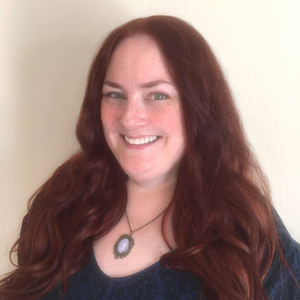 Mary Jamba spoke at the March 23 meeting on Finding Missing Parents
Mary Jamba spoke at the March 23 meeting on Finding Missing Parents
Finding missing parents: That was the focus of the March 23 meeting of the Van Zandt County Genealogical Society, at the main library in Canton. Mary Jamba, a DNA genealogy specialist, gave a presentation on "Finding Unknown Parents and Grandparents with Genetic Genealogy."
Ms. Jamba used examples from her own family and from her work with clients to show how the new knowledge from DNA testing has enabled adoptees to find parents, and families with scanty documentation to complete their family trees. She stressed that learning to use DNA data is not difficult: One has to be able to do basic arithmetic, not understand complicated DNA science. She noted that often researchers find DNA makes them more interested in genealogy than ever before, because it yields often surprising answers.
The key to success with DNA, Ms. Jamba said, is for researchers to compare their DNA data to as many others’ data as possible, to find people who are relatives, and to check out the family trees of those people. Ms. Jamba said she uses Ancestry DNA most often, but that all the genealogy DNA companies such as Family Search have valuable information, and she uses them all. She showed the group how to go from zero knowledge of client’s parents to finding those parents. Once a person starts, Ms. Jamba said, gathering more data gets easier. She has worked on hundreds of cases of missing parents, often finding them and helping people learn where they came from.
Ms. Jamba is a genealogist with 28 years of experience. Her formal education includes degrees in psychology, human development, and religion. She has worked in varied careers such as addiction counselor, hypnotist, artist, and educator, in addition to genealogy. She has owned, operated and managed several small businesses and co-ops. She is a member of many family research organizations, including the Association of Professional Genealogists (APG), National Genealogical Society (NGS), and the Computer Assisted Genealogy Group (CAGG).
Society President Carrie Woolverton and Second Vice President Imogene Kirkpatrick reminded attendees about the valuable information available on the Van Zandt County Genealogical Society’s Facebook page, https://www.facebook.com/VanZandtCountyGenealogy; and our website.
Ms. Jamba used examples from her own family and from her work with clients to show how the new knowledge from DNA testing has enabled adoptees to find parents, and families with scanty documentation to complete their family trees. She stressed that learning to use DNA data is not difficult: One has to be able to do basic arithmetic, not understand complicated DNA science. She noted that often researchers find DNA makes them more interested in genealogy than ever before, because it yields often surprising answers.
The key to success with DNA, Ms. Jamba said, is for researchers to compare their DNA data to as many others’ data as possible, to find people who are relatives, and to check out the family trees of those people. Ms. Jamba said she uses Ancestry DNA most often, but that all the genealogy DNA companies such as Family Search have valuable information, and she uses them all. She showed the group how to go from zero knowledge of client’s parents to finding those parents. Once a person starts, Ms. Jamba said, gathering more data gets easier. She has worked on hundreds of cases of missing parents, often finding them and helping people learn where they came from.
Ms. Jamba is a genealogist with 28 years of experience. Her formal education includes degrees in psychology, human development, and religion. She has worked in varied careers such as addiction counselor, hypnotist, artist, and educator, in addition to genealogy. She has owned, operated and managed several small businesses and co-ops. She is a member of many family research organizations, including the Association of Professional Genealogists (APG), National Genealogical Society (NGS), and the Computer Assisted Genealogy Group (CAGG).
Society President Carrie Woolverton and Second Vice President Imogene Kirkpatrick reminded attendees about the valuable information available on the Van Zandt County Genealogical Society’s Facebook page, https://www.facebook.com/VanZandtCountyGenealogy; and our website.
Organized family research will help future generations
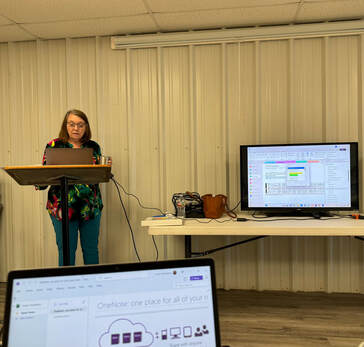 Barbara Coakley shows the crowd how to use OneNote for research
Barbara Coakley shows the crowd how to use OneNote for research
Barbara Coakley, a highly-respected genealogy speaker, made a much-anticipated return to the Van Zandt County Genealogical Society’s monthly meeting, held February 24, 2024, at Holy Cross Lutheran Church in Canton, Texas. Her welcome message was that we don’t have to be buried in paper.
Ms. Coakley showed attendees how to cut down on stacks of documents and disorganized computer files with Microsoft OneNote, a program that enables genealogists to arrange their research on their computers or other electronic devices. She stressed that getting files organized on OneNote isn’t just a way to store things in a smaller space—it makes doing research faster, easier, and more fun. She showed the crowd how to use the program, with examples from how she organized her family genealogy documents.
Ms. Coakley noted that she has many, many shelves of 3-ring binders with decades of research that filled a walk-in closet. She knew she needed assistance to get the work arranged and family stories written. OneNote, she said, is a program with terms and structure that closely resemble traditional paper files and binders, so it wasn’t hard to transition her binders to computer files. She spoke of her wish to have the research of a lifetime presented in a way that it won’t be thrown away by those who don’t want to dig through stacks of paper. Using a computer file organizing program like OneNote makes it easier to write up years of research into a story to be given to family or local historical societies, or at least to have the information in an easily searchable form that doesn’t fill up a big box—or a walk-in closet.
There are many computer programs besides OneNote that help people organize their files, such as Scrivener, Evernote, and others, said Ms. Coakley, and she encouraged people to check them out. Most are not free, including OneNote, but they are worth it. She stressed that organized information is more likely to be passed on to future generations.
Ms. Coakley is a genealogist with 30 years of experience. She has taught college classes in genealogy and has given presentations to genealogical societies all over the U.S. and in Great Britain. Her website is at https://coakleysennottfamilyhistory.weebly.com/
Ms. Coakley showed attendees how to cut down on stacks of documents and disorganized computer files with Microsoft OneNote, a program that enables genealogists to arrange their research on their computers or other electronic devices. She stressed that getting files organized on OneNote isn’t just a way to store things in a smaller space—it makes doing research faster, easier, and more fun. She showed the crowd how to use the program, with examples from how she organized her family genealogy documents.
Ms. Coakley noted that she has many, many shelves of 3-ring binders with decades of research that filled a walk-in closet. She knew she needed assistance to get the work arranged and family stories written. OneNote, she said, is a program with terms and structure that closely resemble traditional paper files and binders, so it wasn’t hard to transition her binders to computer files. She spoke of her wish to have the research of a lifetime presented in a way that it won’t be thrown away by those who don’t want to dig through stacks of paper. Using a computer file organizing program like OneNote makes it easier to write up years of research into a story to be given to family or local historical societies, or at least to have the information in an easily searchable form that doesn’t fill up a big box—or a walk-in closet.
There are many computer programs besides OneNote that help people organize their files, such as Scrivener, Evernote, and others, said Ms. Coakley, and she encouraged people to check them out. Most are not free, including OneNote, but they are worth it. She stressed that organized information is more likely to be passed on to future generations.
Ms. Coakley is a genealogist with 30 years of experience. She has taught college classes in genealogy and has given presentations to genealogical societies all over the U.S. and in Great Britain. Her website is at https://coakleysennottfamilyhistory.weebly.com/
Come join the club(s)! Carrie Woolverton speaks about lineage societies.
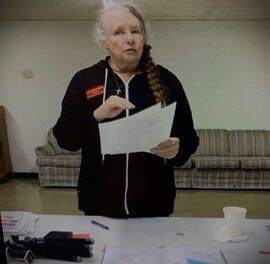
Genealogists learned about honoring their ancestors by joining lineage societies at the January 27 meeting of the Van Zandt County Genealogical Society at the Senior Center in Canton.
Carrie Wilson Woolverton, President of the Society, gave the program, which provided extensive information on lineage societies such as the Sons of the American Revolution, Daughters of the War of 1812, United Daughters of the Confederacy, and many more. Ms. Woolverton noted that there are hundreds of lineage societies, and all these groups provide community service, scholarships and other benefits to society at large. She stressed that nearly all genealogists are able to join such groups; all it takes is research to prove a family line. Lineage society volunteers are happy to help applicants with their research.
Membership in a lineage society provides a lot of advantages, according to Ms. Woolverton. Joining a society such as Daughters of the American Revolution allows an applicant to bring an ancestor’s name out of the past and honor that person now. For researchers who want to be sure their research is kept somewhere permanent, joining a society is a must, as the groups keep all the applications and proofs in their records forever and will share it with other researchers. The societies’ staffs review applicants’ proofs of lineage, so that researchers can be confident that their family research is sound. Most importantly, said Ms. Woolverton, joining a lineage society is fun, and allows us to find distant cousins and further our research. It is a way to socialize with people who are interested in history and genealogy. Many people belong to multiple societies, and there is a group for everyone. Ms. Woolverton passed out a list of dozens of societies, and spoke of groups such as the society of Colonial Tavern Keepers, the Society of Saints and Sinners, and the Society of Descendants of Lady Godiva. History can be humorous!
The full January 27 meeting can be watched on video by visiting the Van Zandt County Genealogy Library’s Facebook page at https://www.facebook.com/VanZandtCountyGenealogy/videos/939756311088770. Those interested in joining a lineage society can email Carrie Woolverton at the Genealogical Society at [email protected].
Attendees at the meeting enjoyed a potluck lunch and socializing before the meeting, and there was a drawing for door prizes—DNA kits. Ms. Woolverton reminded everyone that the April workshop by the Van Zandt County Genealogical Society would focus on DNA research. She also announced that the Genealogical Society had agreed to develop a Genealogy Merit Badge for local Scouts and expects to have that program completed soon.
Ms. Woolverton also reminded everyone of the excellent resources the main Sarah Norman Van Zandt County Library provides for children and people of all ages. She praised the skill and dedication of the staff and volunteers of the main library.
Carrie Wilson Woolverton, President of the Society, gave the program, which provided extensive information on lineage societies such as the Sons of the American Revolution, Daughters of the War of 1812, United Daughters of the Confederacy, and many more. Ms. Woolverton noted that there are hundreds of lineage societies, and all these groups provide community service, scholarships and other benefits to society at large. She stressed that nearly all genealogists are able to join such groups; all it takes is research to prove a family line. Lineage society volunteers are happy to help applicants with their research.
Membership in a lineage society provides a lot of advantages, according to Ms. Woolverton. Joining a society such as Daughters of the American Revolution allows an applicant to bring an ancestor’s name out of the past and honor that person now. For researchers who want to be sure their research is kept somewhere permanent, joining a society is a must, as the groups keep all the applications and proofs in their records forever and will share it with other researchers. The societies’ staffs review applicants’ proofs of lineage, so that researchers can be confident that their family research is sound. Most importantly, said Ms. Woolverton, joining a lineage society is fun, and allows us to find distant cousins and further our research. It is a way to socialize with people who are interested in history and genealogy. Many people belong to multiple societies, and there is a group for everyone. Ms. Woolverton passed out a list of dozens of societies, and spoke of groups such as the society of Colonial Tavern Keepers, the Society of Saints and Sinners, and the Society of Descendants of Lady Godiva. History can be humorous!
The full January 27 meeting can be watched on video by visiting the Van Zandt County Genealogy Library’s Facebook page at https://www.facebook.com/VanZandtCountyGenealogy/videos/939756311088770. Those interested in joining a lineage society can email Carrie Woolverton at the Genealogical Society at [email protected].
Attendees at the meeting enjoyed a potluck lunch and socializing before the meeting, and there was a drawing for door prizes—DNA kits. Ms. Woolverton reminded everyone that the April workshop by the Van Zandt County Genealogical Society would focus on DNA research. She also announced that the Genealogical Society had agreed to develop a Genealogy Merit Badge for local Scouts and expects to have that program completed soon.
Ms. Woolverton also reminded everyone of the excellent resources the main Sarah Norman Van Zandt County Library provides for children and people of all ages. She praised the skill and dedication of the staff and volunteers of the main library.
Merry Christmas! Librarians Celebrate the Season
|
Librarians for the Van Zandt County Library of Genealogy and Local History had a get-together to celebrate the holiday season recently. It was a time to visit, reflect on the past year, and be grateful for the continued opportunity to help county residents and all others who have an interest in genealogy and history. President Carrie Woolverton had printed photos of all the activities of the Genealogical Society in 2023 and spread them out on the library table for everyone to reminisce about.
We appreciate our dedicated librarians, all of whom are volunteers. And the librarians appreciate county officials who make the space available in the Courthouse Annex for the Genealogy Library. Most of all, everyone is grateful to our patrons, with their interest in family research and the past. The visitors to our library keep us motivated. Happy Holidays to all! And best wishes for a good 2024. |
|
Honoring a Very Early Explorer: Historical Marker Rededication November 27
In the 1700s, the area that became East Texas was a beautiful place, inhabited by various tribes who had been here for centuries. But the written record of those times is extremely sparse. Luckily, a Franciscan friar named Jose Calahorra arrived in the early 1700s as a missionary to the native peoples, keeping a diary of his travels--a gold mine of information. Calahorra's life and legacy were honored on November 27, 2023 at the Fruitvale Community Center. A replacement historical marker was dedicated to Jose Francisco Calahorra y Saenz in a lunch gathering and ceremony sponsored by the Old Dallas-Shreveport Road Preservation Association, the Van Zandt County Historical Commission and the Jose Francisco Calahorra Chapter of the Daughters of the American Colonists (DAC).
Commissioner Chad LaPrade of Precinct 1 spoke at the event, expressing his admiration for the work of the groups and volunteers who made the historical marker dedication possible and who help preserve local history. Karen Hall, Regent of the Jose Francisco Calahorra DAC Chapter, spoke of her appreciation of all that the Van Zandt County lineage societies and historical associations have accomplished in keeping the memory of our forebears alive. Elvis Allen, of the Dallas-Shreveport Road Association (and Chairman of the Van Zandt County Historical Commission), gave a brief history of Calahorra’s life and work. He also praised the work of DAC member Sherrie Archer in coordinating the historical marker ceremony.
Father Jose Francisco Calahorra y Saenz was a first and foremost a missionary to the tribes of our area, but also an astute observer of the peoples and lands he visited. He earned the respect of his fellow Spaniards and the native tribes. His writings are among the earliest regarding the area that later became Van Zandt County and surrounding counties. Calahorra's visits through the region spanned at least 30 years, from the 1730s to the 1760s. In his later years, he was a teacher in Zacatecas, Mexico, where he died in 1774.
A historical marker dedicated to Calahorra had stood for many years before being vandalized. The ceremony on November 27 dedicated a replacement marker in the Fruitvale area.
Commissioner Chad LaPrade of Precinct 1 spoke at the event, expressing his admiration for the work of the groups and volunteers who made the historical marker dedication possible and who help preserve local history. Karen Hall, Regent of the Jose Francisco Calahorra DAC Chapter, spoke of her appreciation of all that the Van Zandt County lineage societies and historical associations have accomplished in keeping the memory of our forebears alive. Elvis Allen, of the Dallas-Shreveport Road Association (and Chairman of the Van Zandt County Historical Commission), gave a brief history of Calahorra’s life and work. He also praised the work of DAC member Sherrie Archer in coordinating the historical marker ceremony.
Father Jose Francisco Calahorra y Saenz was a first and foremost a missionary to the tribes of our area, but also an astute observer of the peoples and lands he visited. He earned the respect of his fellow Spaniards and the native tribes. His writings are among the earliest regarding the area that later became Van Zandt County and surrounding counties. Calahorra's visits through the region spanned at least 30 years, from the 1730s to the 1760s. In his later years, he was a teacher in Zacatecas, Mexico, where he died in 1774.
A historical marker dedicated to Calahorra had stood for many years before being vandalized. The ceremony on November 27 dedicated a replacement marker in the Fruitvale area.
At the new historical marker, L-R: Carrie Woolverton, Chad LaPrade, Benja Mize, Lawrence Greer, Elvis Allen, Ronnie Hall, Karen Hall, Suzie Bass, Lou Ann Everett, Lona Hobbs, DeWayne Mouliere, Sherrie Archer, Linda Mays, Jane Hunter, Tammy Mouliere, K. Jenschke
November 2023 Meeting: Show and Tell!
The Van Zandt County Genealogical Society held its yearly November Show and Tell meeting on November 28 at the main library in Canton. As usual, there was a lot to smile about and to learn, focusing on members’ family history.
Janis Crow spoke about her father, Fletcher Hinsley, and his service in World War 11 with the 67th Evacuation Hospital on the front lines, the D Day landing at Omaha Beach in France, the Battle of the Bulge, and more. She brought many interesting photos and artifacts. It was a reminder of how much we owe our veterans.
Becky Rosson also gave a war-themed presentation, bringing in the World War II service book of her father, LaDon Liscum. She also brought an impressive portrait of her maternal great-grandparents, John and Margaret Roberts. She spoke about how she’d rediscovered the photo after thinking it was lost for years.
Lawrence Greer spoke about his family’s long history in Van Zandt County. Mr. Greer’s ancestors include Wentworth Manning, an early county resident who wrote Some History of Van Zandt County (1919). He gave a history of the Manning family, who were very prominent in Van Zandt. He brought photos of all the old relatives he spoke of.
The meeting was as informative as all the Society’s meetings but more personal, as everyone spoke of their own families. As with all family gatherings there were plenty of stories to tell.
Janis Crow spoke about her father, Fletcher Hinsley, and his service in World War 11 with the 67th Evacuation Hospital on the front lines, the D Day landing at Omaha Beach in France, the Battle of the Bulge, and more. She brought many interesting photos and artifacts. It was a reminder of how much we owe our veterans.
Becky Rosson also gave a war-themed presentation, bringing in the World War II service book of her father, LaDon Liscum. She also brought an impressive portrait of her maternal great-grandparents, John and Margaret Roberts. She spoke about how she’d rediscovered the photo after thinking it was lost for years.
Lawrence Greer spoke about his family’s long history in Van Zandt County. Mr. Greer’s ancestors include Wentworth Manning, an early county resident who wrote Some History of Van Zandt County (1919). He gave a history of the Manning family, who were very prominent in Van Zandt. He brought photos of all the old relatives he spoke of.
The meeting was as informative as all the Society’s meetings but more personal, as everyone spoke of their own families. As with all family gatherings there were plenty of stories to tell.
VZ Genealogical Society at Family History Fair in Tyler
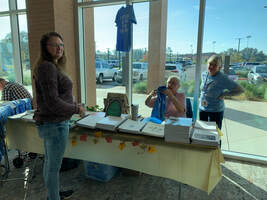 VZCGS librarians Jan Crow and Suzie Bass, center and far right, assisting a customer
VZCGS librarians Jan Crow and Suzie Bass, center and far right, assisting a customer
The Van Zandt County Genealogical Society was part of the excitement at the 21st Annual Family History Fair on November 18, 2023, at the new W.T. Brookshire Center in Tyler, TX. Sponsored by the East Texas Genealogical Society, Family Search, and the Just Serve organization, the Fair was a chance for genealogists to mingle and increase their skills in research, including DNA research. There was plenty of free food, and food trucks provided lots of variety.
Volunteer VZCGS librarians Jan Crow and Suzie Bass staffed the VZCGS booth, giving us a chance to spread the word about VZCGS: A great genealogy library, award-winning newsletter, educational monthly meetings, and lots of books and t-shirts! VZCGS sold plenty of books and t-shirts as well as selling Van Zandt County Historical Commission 2024 Calendars. There were also new members signing up. The Brookshire center was a spacious and attractive venue. Other vendors and county genealogy/history organizations were in attendance; it was a good event.
Volunteer VZCGS librarians Jan Crow and Suzie Bass staffed the VZCGS booth, giving us a chance to spread the word about VZCGS: A great genealogy library, award-winning newsletter, educational monthly meetings, and lots of books and t-shirts! VZCGS sold plenty of books and t-shirts as well as selling Van Zandt County Historical Commission 2024 Calendars. There were also new members signing up. The Brookshire center was a spacious and attractive venue. Other vendors and county genealogy/history organizations were in attendance; it was a good event.
Edgewood Heritage Park Tour October 21:
Fun and History
Van Zandt County Genealogical Society members and friends had their own private tour of the Heritage Park Museum of East Texas in Edgewood on October 21. (See slideshow of more photos, below.) A village of restored Van Zandt County (and some other counties) buildings, vehicles, crafts and furniture, the Heritage Park is a treasure located right here on our doorstep. Check out their website, which includes a terrific video tour, at https://heritageparkmuseumofetx.org/
Attendees walked through a restored train caboose and train station, a barbershop, a cafe where Bonnie and Clyde used to hang out, and lots of other interesting places. The Heritage Park has a covered wagon, carriages and other vehicles. Everyone learned about Van Zandt County history and reminisced about things some of them remembered from childhood--like old gas stoves, no indoor plumbing, kerosene lanterns. Did you know that most stores had a dominoes game going in the back of the store in the winter time, played by old men from the community?
We owe a big debt of thanks to the Heritage Park for keeping it open for us to have a private tour. Many thanks also to Joanne Hall, docent at the Park, who worked overtime to tell us about the buildings, crafts and other things of interest.
The weather was beautiful, perfect for a stroll through history.
Attendees walked through a restored train caboose and train station, a barbershop, a cafe where Bonnie and Clyde used to hang out, and lots of other interesting places. The Heritage Park has a covered wagon, carriages and other vehicles. Everyone learned about Van Zandt County history and reminisced about things some of them remembered from childhood--like old gas stoves, no indoor plumbing, kerosene lanterns. Did you know that most stores had a dominoes game going in the back of the store in the winter time, played by old men from the community?
We owe a big debt of thanks to the Heritage Park for keeping it open for us to have a private tour. Many thanks also to Joanne Hall, docent at the Park, who worked overtime to tell us about the buildings, crafts and other things of interest.
The weather was beautiful, perfect for a stroll through history.
Gen. Society Members sell books at Canton Autumn Festival 2023
Van Zandt County Genealogical Society members Linda Dennis and Susie Brey staffed our booth at the 22nd Autumn Festival on October 14th, 2023. This event, one of the many happening regularly in our communities in Van Zandt County, is fun for the whole family, with good local food, activities, and things to see and buy. Speaking of buying, Susie and Linda sold Van Zandt County Genealogical Society t-shirts and the many books the Society has for sale. Check out our Store page for just a sampling of what we have to offer.
Many thanks to Linda and Susie! It was a great event, and they helped get the Genealogy word out!
Many thanks to Linda and Susie! It was a great event, and they helped get the Genealogy word out!
Below left: Susie Brey works at the Genealogical Society table at Canton Autumn Festival. Below right: Linda Dennis with friends.
2023 Fall Genealogy Seminar A Great Success!
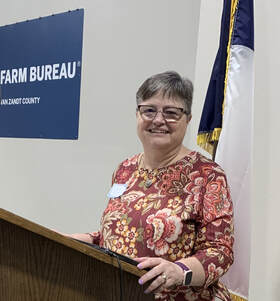 Emily Richardson speaks at the Seminar
Emily Richardson speaks at the Seminar
The annual Fall Genealogy Seminar was a fun and knowledge-packed experience for all, taught by genealogist Emily Coffman Richardson, Ed.D. The seminar, held at the Farm Bureau Event Center in Canton on September 23, focused on making everyone’s research experience more efficient, with less wasted time and more solid information.
Ms. Richardson taught four classes during the day-long event, and there was something for all levels of genealogist, from complete beginner to professional. Noting that all genealogists can get stuck on a tough problem (great-grandfather gone missing, not knowing an ancestor’s maiden name, etc.), she stressed keeping focused on a clear question and not get sidetracked. Using examples from her own ancestors, half of whom seemed to be named Fox, she addressed the dreaded problem of relatives all being given the same or similar names, which kept the class laughing as well as learning. Of particular interest to attendees was her presentation of the 20 most important websites for genealogists, which included sites with foreign country research information, interactive maps, tutorials, and all sorts of unconventional materials for genealogists. Finally, Ms. Richardson showed the class how much they’d been missing in their research in military records. More and more military information is being found and made available, she noted, so circling back to recheck one’s research can be rewarding. Attendees were impressed with Ms. Richardson’s depth of knowledge and decades of experience.
The event gave area genealogists the chance to socialize and share research stories. Continental breakfast, lunch and snacks were served, and door prizes were given out during the breaks. Just for fun, attendees who had loaded the Family Search app on their cellphones were able to find cousins (some as distant as 9th or 10th) in the room.
Ms. Richardson of Denton, Texas, retired from higher education in 2019. She had been helping with her mother’s genealogy business part-time for many years and continued that work when her mother passed away. She opened a genealogy business called Kinsearchers, the original name of her mother’s business, providing family research assistance to clients. Ms. Richardson teaches and lectures extensively. She is the secretary of the Texas State Genealogical Society, as well as District C Representative. She is on the board for the Robson Ranch Genealogy Club. She teaches genealogy courses for the Osher Lifelong Learning Institute (OLLI) for the University of North Texas. Emily has been the Registrar for The Flower Mound NSDAR chapter and currently serves on the State Application Team for DAR. Her website is kinsearchers.weebly.com.
Ms. Richardson taught four classes during the day-long event, and there was something for all levels of genealogist, from complete beginner to professional. Noting that all genealogists can get stuck on a tough problem (great-grandfather gone missing, not knowing an ancestor’s maiden name, etc.), she stressed keeping focused on a clear question and not get sidetracked. Using examples from her own ancestors, half of whom seemed to be named Fox, she addressed the dreaded problem of relatives all being given the same or similar names, which kept the class laughing as well as learning. Of particular interest to attendees was her presentation of the 20 most important websites for genealogists, which included sites with foreign country research information, interactive maps, tutorials, and all sorts of unconventional materials for genealogists. Finally, Ms. Richardson showed the class how much they’d been missing in their research in military records. More and more military information is being found and made available, she noted, so circling back to recheck one’s research can be rewarding. Attendees were impressed with Ms. Richardson’s depth of knowledge and decades of experience.
The event gave area genealogists the chance to socialize and share research stories. Continental breakfast, lunch and snacks were served, and door prizes were given out during the breaks. Just for fun, attendees who had loaded the Family Search app on their cellphones were able to find cousins (some as distant as 9th or 10th) in the room.
Ms. Richardson of Denton, Texas, retired from higher education in 2019. She had been helping with her mother’s genealogy business part-time for many years and continued that work when her mother passed away. She opened a genealogy business called Kinsearchers, the original name of her mother’s business, providing family research assistance to clients. Ms. Richardson teaches and lectures extensively. She is the secretary of the Texas State Genealogical Society, as well as District C Representative. She is on the board for the Robson Ranch Genealogy Club. She teaches genealogy courses for the Osher Lifelong Learning Institute (OLLI) for the University of North Texas. Emily has been the Registrar for The Flower Mound NSDAR chapter and currently serves on the State Application Team for DAR. Her website is kinsearchers.weebly.com.
Attention all who have old Van Zandt County roots: Are you eligible for a 100 Year or First Families Certificate? See below. There is also more information on these programs and on the Early Settlers of Van Zandt County certificate/medallion program, on our Services page on this website.
Library of Genealogy and Local History
County Courthouse Annex, Suite 104 (East End of Building)
P O Box 1388
Canton, Texas 75103
Our Phone Number, Email link and Facebook link are below, along with other useful links.
Library Hours
Monday through Friday: 10 AM to 3 PM Closed Sunday and Holidays
Saturday: 10 AM to12:30 PM
Please call before making a long trip as there are some unforeseen circumstances that call for us being closed from time to time.
Monday through Friday: 10 AM to 3 PM Closed Sunday and Holidays
Saturday: 10 AM to12:30 PM
Please call before making a long trip as there are some unforeseen circumstances that call for us being closed from time to time.
The Library offers four computers with internet access, Ancestry.com (Ancestry Library), History Geo, newspapers online, microfilm of local county newspapers, marriages licenses, various other county records, and microfilm Census records (if you like researching the old-fashioned way). We offer quite a few books relating to Van Zandt County specifically, and books of other Texas counties as well as other states. We are a great little library for genealogy research.
Useful Genealogy & History Links
Van Zandt County Historical Commission www.vanzandthistoricalcommission.com/
Texas State Genealogical Society www.txsgs.org/
Van Zandt County, Texas History (Facebook): www.facebook.com/VZTXHistory
Texas Historical Commission www.thc.texas.gov/
East Texas Genealogical Society www.etgs.org/
The Portal to Texas History texashistory.unt.edu/
Texas State Library and Archives Commission www.tsl.texas.gov/arc
Texas General Land Office www.glo.texas.gov
Texas State Genealogical Society www.txsgs.org/
Van Zandt County, Texas History (Facebook): www.facebook.com/VZTXHistory
Texas Historical Commission www.thc.texas.gov/
East Texas Genealogical Society www.etgs.org/
The Portal to Texas History texashistory.unt.edu/
Texas State Library and Archives Commission www.tsl.texas.gov/arc
Texas General Land Office www.glo.texas.gov
